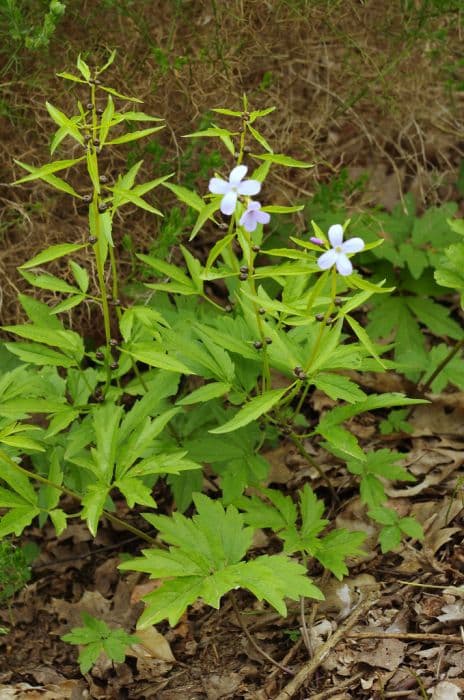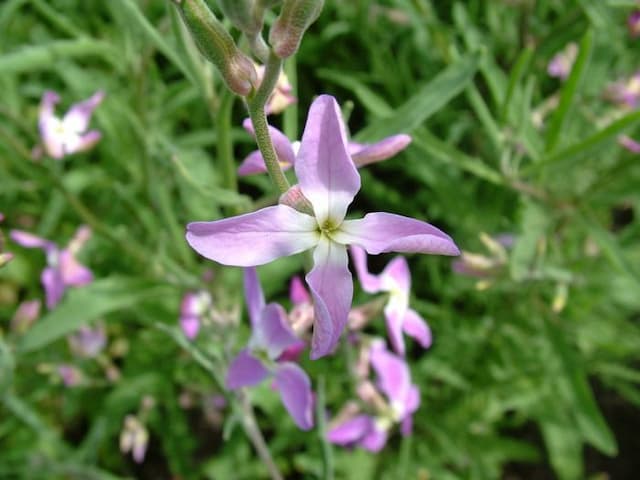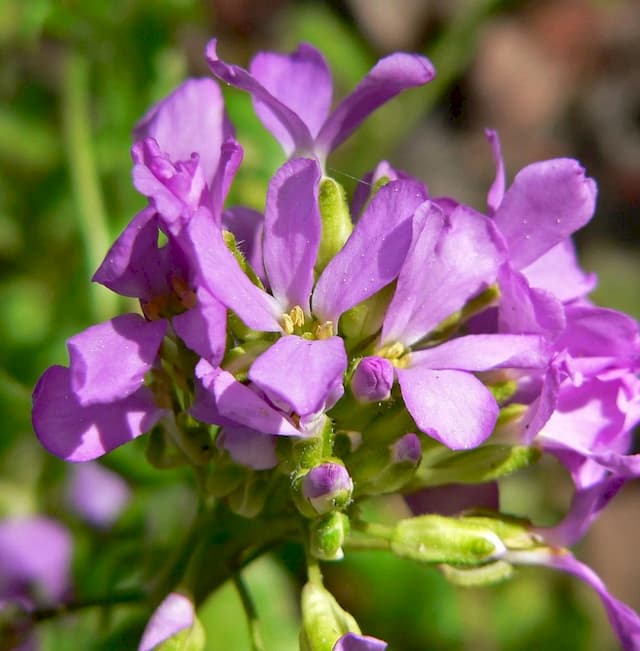False Rockcress Aubrieta 'Ida'

ABOUT
Aubrieta 'Ida', commonly known as the rock cress, is a perennial plant known for its vibrant and attractive appearance. It features small, ovate to spoon-shaped leaves that are densely packed, creating a lush mounding and cascading habit. The foliage is typically a rich green shade, which contrasts beautifully with the stunning flowers it produces. The rock cress blooms profusely in the spring, covering the foliage with masses of small, four-petaled flowers. The blooms of 'Ida' come in a striking shade of purple, which adds a vivid splash of color to garden spaces. The flowers are often seen blanketing rock walls and crevices, spilling artfully over stone ledges or gracing the front borders of garden beds. With its lush foliage and profusion of colorful flowers, Aubrieta 'Ida' remains a favorite among gardeners for creating impactful ground coverage in sunny to partially shaded areas. Its ability to attract pollinators, like bees and butterflies, adds to its charm, making it not only a visually appealing plant but also beneficial for the ecosystem.
About this plant
 Names
NamesFamily
Brassicaceae
Synonyms
Rock Cress, Aubretia, Purple Rock Cress, Rainbow Rock Cress, False Rockcress
Common names
Aubrieta 'Ida'
 Toxicity
ToxicityTo humans
Rock cress, commonly known as Aubrieta 'Ida', is generally considered non-toxic to humans. There are no well-documented cases of poisoning from this plant, and it is not known to contain any toxic substances that would pose a threat to human health. Therefore, ingesting parts of the rock cress is not expected to cause poisoning or severe adverse effects. However, consuming any non-food plant can potentially cause some discomfort or an allergic reaction in sensitive individuals.
To pets
Rock cress, or Aubrieta 'Ida', is also considered to be non-toxic to pets, including cats and dogs. It does not contain known toxic compounds that would cause poisoning in animals. If your pet ingests parts of the rock cress, it is unlikely to experience any significant toxicological effects. However, as with any non-food plant, ingestion can sometimes lead to mild gastrointestinal upset such as vomiting or diarrhea in sensitive pets.
 Characteristics
CharacteristicsLife cycle
Perennials
Foliage type
Evergreen
Color of leaves
Green
Flower color
Purple
Height
0.25 feet (7.62 cm)
Spread
1.5 feet (45.72 cm)
Plant type
Herb
Hardiness zones
4
Native area
Europe
Benefits
 General Benefits
General Benefits- Low maintenance: Aubrieta 'Ida', commonly known as rock cress, requires minimal care once established, making it ideal for gardeners seeking a low-maintenance option.
- Ground cover: Its dense mat-forming habit makes it effective for controlling weeds and covering bare spots in the garden.
- Drought tolerant: Rock cress is drought resistant once established, requiring less watering compared to other plants, which conserves water and reduces maintenance.
- Attracts pollinators: The flowers attract bees, butterflies, and other beneficial insects, promoting pollination in the garden.
- Spring blossoms: It offers vibrant floral displays in the spring, adding a burst of color to landscapes after the winter months.
- Erosion control: The plant's spreading nature helps stabilize soil on slopes and can prevent soil erosion.
- Rock garden suitability: Aubrieta 'Ida' is an ideal choice for rock gardens due to its alpine origins and ability to thrive in rocky, well-drained soils.
- Versatile use: It can be planted in borders, over walls, in containers, and alongside pathways, making it a versatile addition to various garden designs.
 Medical Properties
Medical PropertiesThis plant is not used for medical purposes.
 Air-purifying Qualities
Air-purifying QualitiesThis plant is not specifically known for air purifying qualities.
 Other Uses
Other Uses- Aubrieta can be used to create a colorful ground cover that helps prevent soil erosion on slopes or banks, as its spreading habit forms a living mat that stabilizes the soil.
- The blooms of the Aubrieta can be edible when used sparingly as a garnish, adding a vibrant touch to salads and desserts.
- Aubrieta can be planted in crevices of dry walls or rockeries, making it useful for gardeners looking to beautify stony, hard-to-plant areas.
- This plant is often used in butterfly gardens as it provides a nectar source in early spring, attracting pollinators to the landscape.
- The dense foliage of Aubrieta is useful as a living mulch, helping to suppress weeds and maintain soil moisture.
- When planted on graves, Aubrieta adds color and life, symbolizing remembrance and is often used for this purpose in rock garden cemeteries.
- The use of Aubrieta in green roofing can contribute to urban biodiversity, providing habitats for insects and small birds in city environments.
- Aubrieta can serve as inspiration for artists and photographers due to its vibrant purple hues, which make a popular subject for nature-inspired artwork.
- Dried Aubrieta flowers can be used in potpourri mixtures, offering their mild fragrance to the blend.
- Garden designers often use Aubrieta for its aesthetic cascading effect when planted atop retaining walls or garden borders.
Interesting Facts
 Feng Shui
Feng ShuiThe Aubrieta is not used in Feng Shui practice.
 Zodiac Sign Compitability
Zodiac Sign CompitabilityThe Aubrieta is not used in astrology practice.
 Plant Symbolism
Plant Symbolism- Resilience: Aubrieta, commonly known as Rock Cress, often grows in rocky, alpine regions, symbolizing the ability to thrive in challenging conditions and overcome adversity.
- Persistence: Given its vigorous growth habit and tendency to spread across even inhospitable terrain, Rock Cress represents determination and the drive to succeed.
- Beauty: With its richly colored blooms, Rock Cress is a symbol of natural beauty, indicating admiration and love for the simple, yet stunning gifts of nature.
- Survival: As a plant that can withstand harsh environments, Rock Cress embodies the spirit of survival and enduring life.
- Growth: Rock Cress's ability to multiply and cover ground quickly is symbolic of personal growth, expansion, and the flourishing of ideas or relationships.
 Water
WaterThe Rock Cress should be watered moderately, aiming for consistently moist but not waterlogged soil. During the growing season, water when the top inch of soil feels dry to the touch, which typically means once a week. However, this can vary depending on weather conditions and soil type. In hot, dry periods, watering may need to be increased. A good practice is to provide the plant with about one gallon of water every week or two, adjusting as necessary for rainfall and temperature changes. Overwatering can lead to root rot, so ensure adequate drainage and reduce watering in the winter months when the plant is dormant.
 Light
LightRock Cress thrives best in full sun to partial shade. The ideal spot for the plant would be an area that receives at least 4 to 6 hours of direct sunlight daily. While the plant can tolerate some shade, too much will diminish flowering and can lead to leggy growth. Ensure the location is protected from harsh afternoon sun in hotter climates to prevent scorching of the foliage.
 Temperature
TemperatureRock Cress is hardy and can withstand a range of temperatures, but it flourishes best in conditions between 50°F and 75°F. The plant can survive minimum temperatures down to 20°F and can handle brief periods of frost. To ensure robust health and optimal blooming, keep it within the ideal temperature range as much as possible, avoiding prolonged exposure to extreme heat or cold.
 Pruning
PruningPruning Rock Cress is essential for maintaining a tidy appearance and encouraging dense growth. After the plant has finished blooming, lightly trim back the spent flowers to promote a second bloom and prevent the plant from getting leggy. Pruning is most effective when done annually in early spring or immediately after the first flowering. This will also help to invigorate the plant for the coming season.
 Cleaning
CleaningNot needed
 Soil
SoilThe best soil mix for Rock Cress 'Ida' is well-draining with a mix of garden soil, compost, and sharp grit or gravel to enhance drainage. It prefers a neutral to slightly alkaline soil pH, around 7.0 to 7.5.
 Repotting
RepottingRock Cress 'Ida' is a low-maintenance, ground-hugging plant that typically does not require frequent repotting. It may only need repotting to refresh the soil every few years or if it outgrows its container.
 Humidity & Misting
Humidity & MistingRock Cress 'Ida' thrives best in low to moderate humidity levels as it is accustomed to open, airy environments being an alpine plant. High humidity levels are often not necessary or beneficial.
 Suitable locations
Suitable locationsIndoor
Provide bright light, cool temperature, and good air circulation for Rock Cress 'Ida'.
Outdoor
Ensure full sun, well-draining soil, and space plants 15cm apart for Rock Cress 'Ida'.
Hardiness zone
4-9 USDA
 Life cycle
Life cycleAubrieta 'Ida', commonly known as Rock Cress, begins its life cycle as a seed that germinates in cool temperatures, usually in early spring or late winter. The seedling quickly develops into a low-growing, mat-forming perennial with small, oval-shaped leaves. Flowering occurs in mid to late spring, showcasing a profusion of small purple, blue, or pink flowers that attract pollinators. After blooming, the plant sets seed, which can scatter close to the parent plant or be dispersed by wind or wildlife. During the summer months, Aubrieta 'Ida' enters a period of vegetative growth where it can expand its foliage and root system. As winter approaches, the plant's growth slows down, and it may become semi-dormant, relying on its evergreen leaves and robust root system to survive through cold weather until the cycle restarts with the next season's warming temperatures.
 Propogation
PropogationPropogation time
Spring-Early Summer
The Aubrieta 'Ida', commonly known as Rock Cress, is typically propagated through cuttings, which is the most popular method for this plant. To propagate Rock Cress, take stem cuttings in late spring or early summer when the plant's growth is most vigorous. These cuttings should be about 2 to 4 inches (5 to 10 centimeters) long and include several sets of leaves. Remove the lower leaves and dip the cut end in rooting hormone for better chances of success. Then, insert the cutting into a pot filled with a well-draining soil mixture. Ensure the cutting is kept moist and placed in a location with indirect sunlight. Roots usually develop within a few weeks, after which the new Rock Cress plants can be transplanted to their permanent location.








![Aubrieta [Axcent Lilac]](/_next/image?url=https%3A%2F%2Fplants-admin.emdemapps.com%2Fimages%2Fplants%2F%2Fimages%2F604b5e2430fac.png&w=640&q=75)